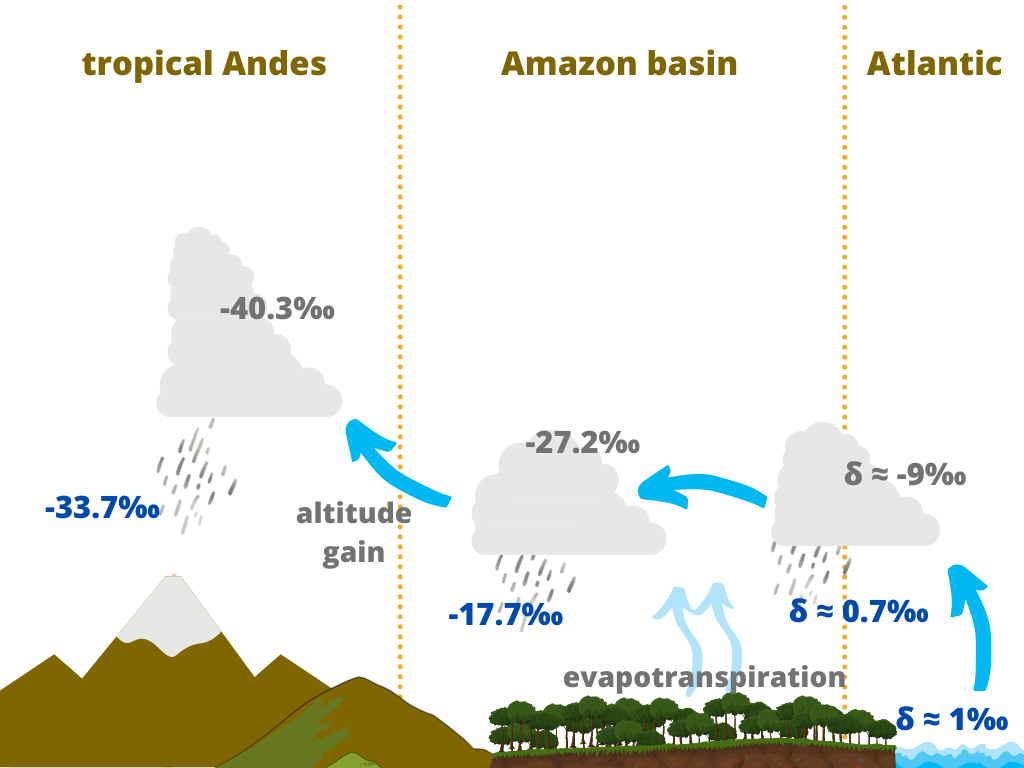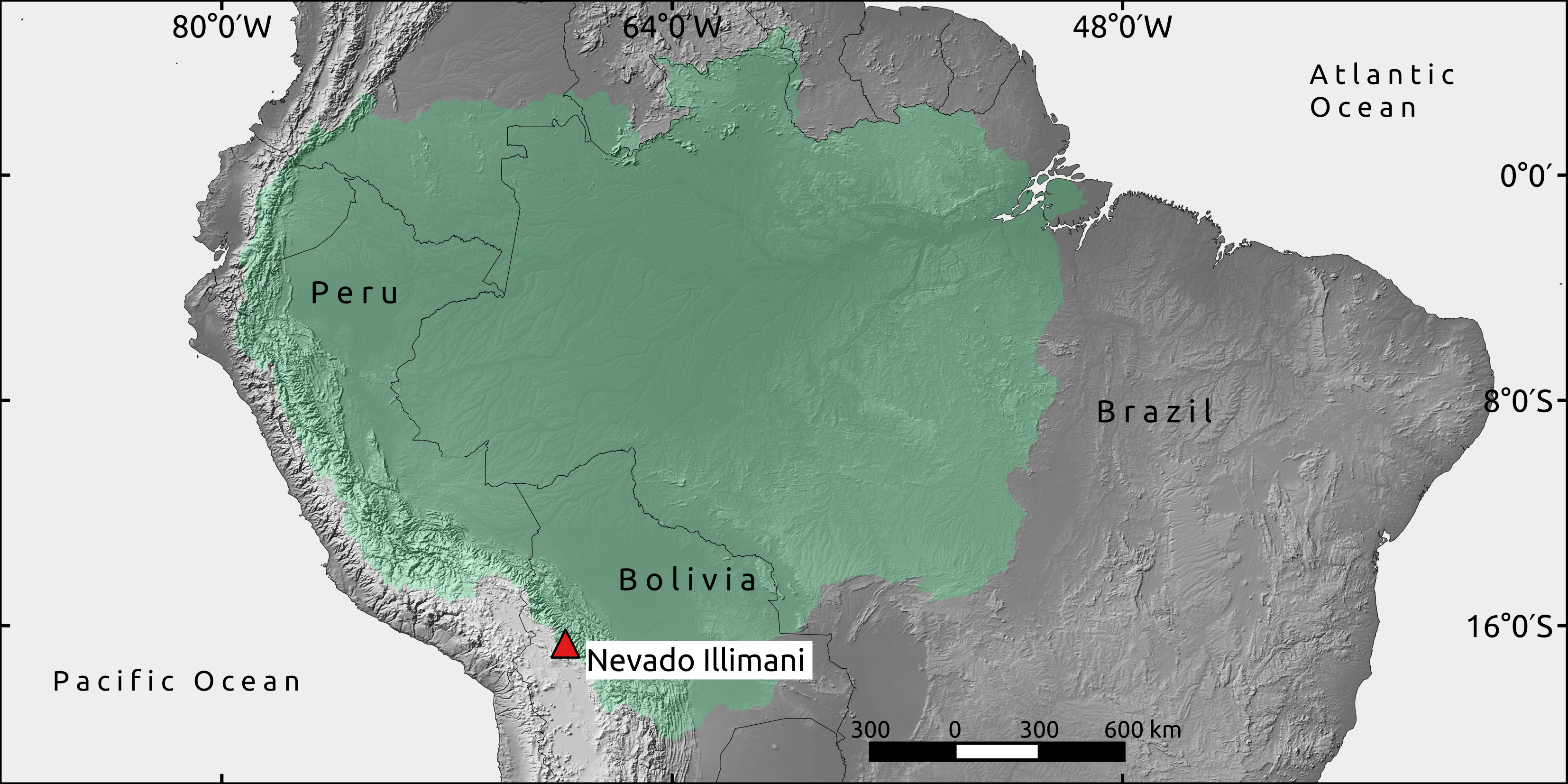An archive of the atmospheric conditions of the Amazon in ice molecules in the Andes
27 May 2021 | Duration of reading: 6 minutes
By Filipe Gaudie Ley Lindau
At the top of the highest Andean mountains, especially in Bolivia, we find glaciers that hold information from the Amazonian atmosphere. This information can be fundamental for the elaboration of mitigation and adaptation strategies to the environmental changes in course, both for communities in the Amazon and in the tropical Andes. In the accumulation zone of these glaciers, successive snow deposits form thick layers of ice, where several characteristics of the atmosphere are kept at the time of snow precipitation. We can access these characteristics by analyzing several chemical, physical and biological parameters in ice cores, as we can see in Figure 1. This topic has already been published here in the Conexões Amazônicas Blog by the researcher Rafael Reis - Past records and connections between Andes and Amazon in ice cores.

Figure 1. Drilling of ice cores, at 6,350 m altitude, in the glacier accumulation zone in Nevado Illimani (Bolivia) during the Ice Memory. On the horizon of the photo is the Amazon basin covered by clouds. Photo: Filipe G. L. Lindau.
And how do we analyze this information stored for thousands of years on glaciers? So, one of the main parameters studied in these archieves is the ratio of stable water isotopes. This ratio expresses the ratio between water molecules with greater mass (mainly ²H216O and 1H218O) and the lighter and more abundant molecule (1H216O). Look, we know that the evaporation of water in water bodies, as well as its condensation in the form of snow or rain, leads to a change in isotopic ratios, since the heavier molecules have less ability to move and less ease to evaporate, and this change in the proportion of isotopes is called isotopic fractionation (Figure 2). stable water isotopes. This ratio expresses the ratio between water molecules with greater mass (mainly ²H216O and 1H218O) and the lighter and more abundant molecule (1H216O). We know that the evaporation of water in water bodies, as well as its condensation in the form of snow or rain, leads to a change in isotopic ratios, since the heavier molecules have less ability to move and less ease to evaporate, and this change in the proportion of isotopes is called isotopic fractionation (Figure 2). As it is a relative measure, expressed by the notation δ, it requires a reference value. For hydrological cycle studies, the reference isotopic compositions of both 2H and 18O are their average isotopic ratios in the water of the oceans.

Figure 2. Representation of isotopic fractionation over tropical South America adapted from Grootes et al. (1989). The δ values indicate the ratio between isotopes 18O and 16O, considering that the condensation occurs under equilibrium conditions. The values in gray and blue represent the ratios in vapour and condensate, respectively.
Through the intensity of isotopic fractionation in the ice cores of the tropical Andes, it is possible to understand the weather conditions at the time of precipitation. For example, in a recent study carried out by the Centro Polar e Climático at UFRGS and research groups from the USA, France and Italy (acess here), we observed a more pronounced isotopic fractionation during summers, when storms were more intense and frequent over the Bolivian Andes. In the Nevado Illimani ice core record (Figure 1), we noticed that the samples that registered a more pronounced isotopic fractionation also had a higher proportion of dust particles considered to be giant (greater than 20 µm, when the suspended dust close to the surface has an average size in the order of 5 µm). This result means that the increase in the proportion of giant dust particles at high altitude suggests the occurrence of summer storms that generate strong winds, making the atmosphere turbulent and capable of suspending and transporting these particles.
The summer storms responsible for the greatest isotopic fractionation of precipitation over the Andes are vital for the communities that inhabit that region, as the rest of the year the conditions are generally arid (Figure 3). These storms are fueled by the humidity of the air masses that travel over the Amazon basin, coming from the Atlantic Ocean. But for these air masses to cross the great physical barrier of the Andes, they need a lot of energy. The necessary energy is provided by the intense condensation of water vapor that occurs when the rains are intense in the Amazon basin.

Figure 3. Panorama of the city of La Paz (Bolivia) with glaciers in the background. Photo: Filipe G. L. Lindau.
Therefore, this study shows that the isotopic record in the Andean ice cores can provide valuable information about how air masses circulate in the Amazon basin (Figure 4), how the humidity of the Atlantic Ocean is distributed in tropical South America and about what is the role of the forest in this circulation of moisture. Greater understanding of these issues can be a key factor in tackling deforestation and major droughts and floods in the Amazon.

Figure 4. The Amazon basin (green region) and Nevado Illimani in the context of tropical South America.
Science is done collaboratively
The Glaciochemistry Laboratory of the Centro Polar e Climático (CPC) at UFRGS analyzes stable water isotopes in ice cores and rainwater samples collected in the Amazon. The CPC is part of the Instituto Nacional de Ciência e Tecnologia da Criosfera (INCT of the Cryosphere), together with eight Brazilian laboratories and several researchers from foreign institutions, dedicated to the study of the variability of different components of the planetary ice mass.
Want to know more? Access the links below!
Espinoza, J. C., Garreaud, R., Poveda, G., Arias, P. A., Molina-Carpio, J., Masiokas, M., Viale, M. Scaff, L. (2020) Hydroclimate of the Andes Part I: Main Climatic Features. Frontier in Earth Science, 8, 1-20. (Link)
Guy, H., Seimon, A., Baker Perry, L., Konecky, B. L., Rado, M., Andrade, M., Potocki, M., Mayewski, P. A. (2019). Subseasonal variations of stable isotopes in tropical Andean precipitation. Journal of Hydrometeorology, 20(5), 915-933 (Link)

Filipe Gaudie Ley Lindau is Chemical Engineer, PhD in Geoscience, concentration area of Geochemistry (UFRGS). He is currently a researcher and postdoc at the Centro Polar e Climático of the Geosciences Institute at UFGRS, where he is dedicated to the recovering, analysis and interpretation of environmental records in ice cores. See more at Lattes and at ResearchGate.
